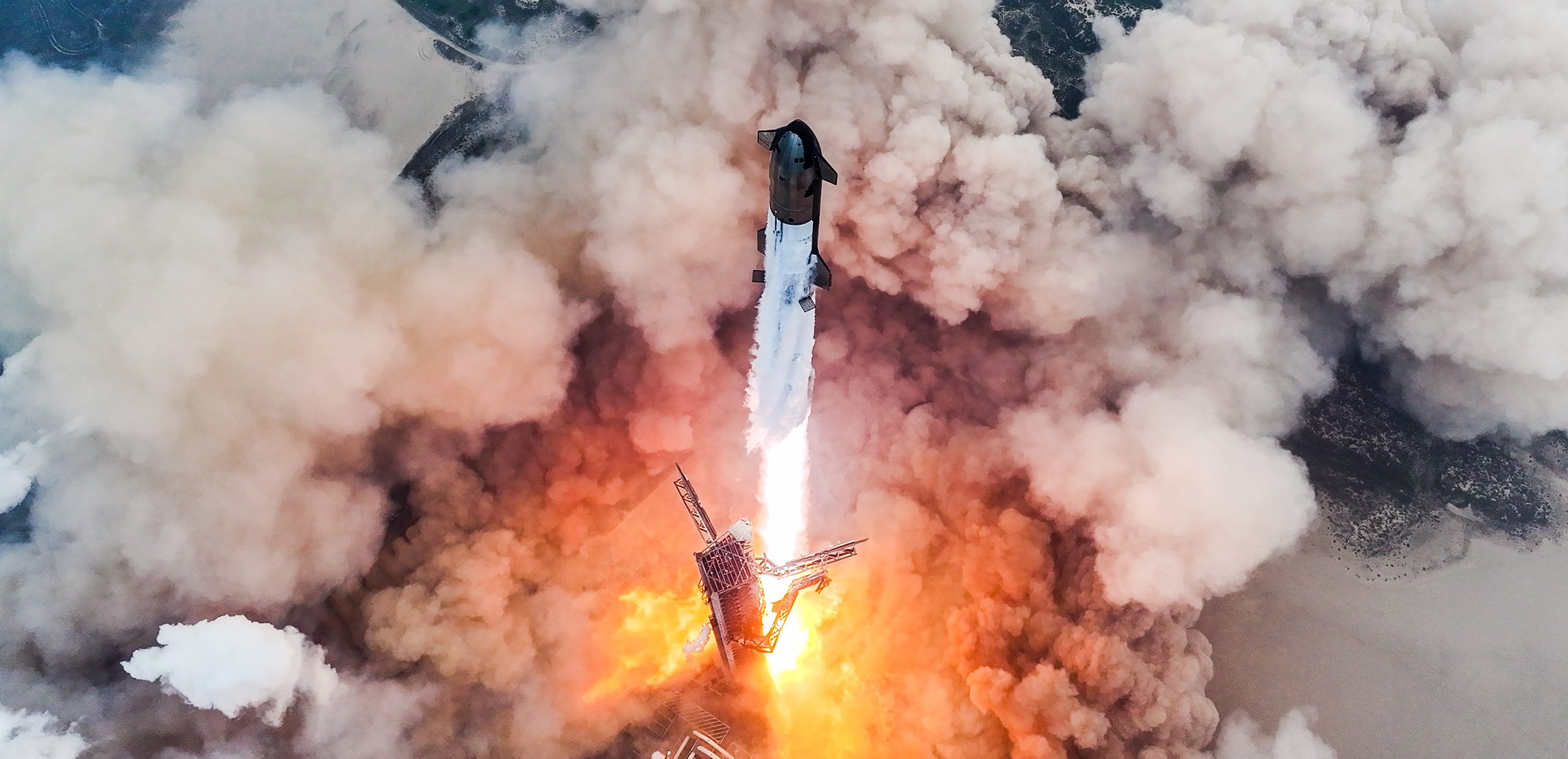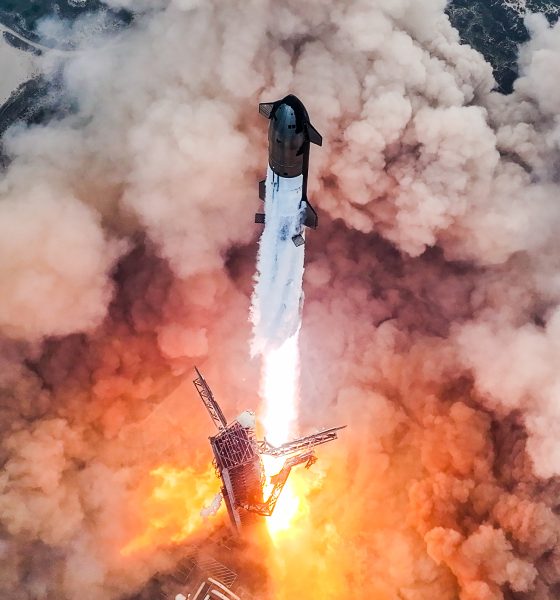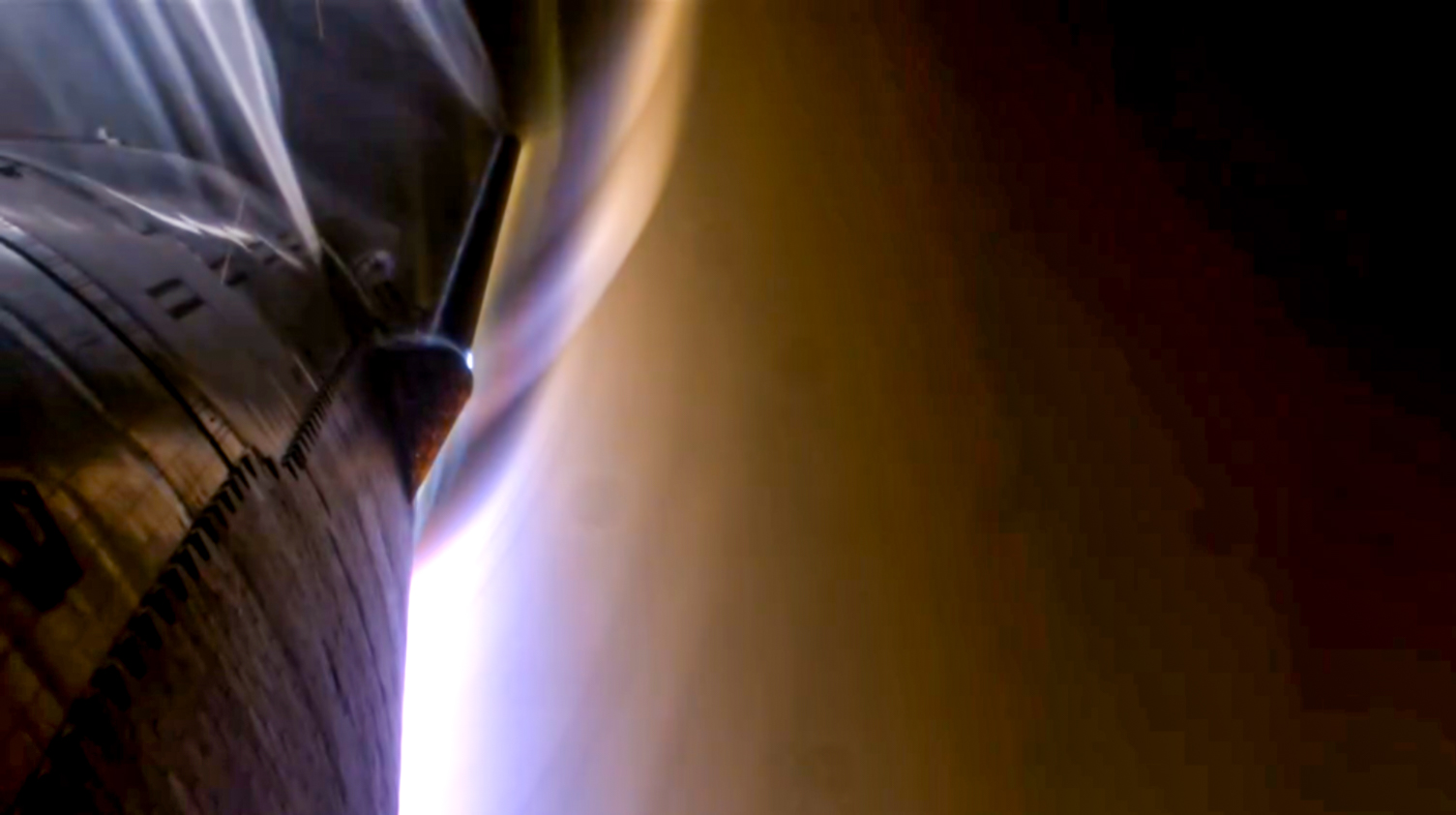

News
SpaceX aces fourth Starship flight test
SpaceX successfully launched and landed its Super Heavy booster and Starship on its fourth integrated flight test, with each making a soft splashdown in the water.
Starship took to the skies at 7:50 am CT from a foggy Starbase, Texas, in an effort to surpass previous flight milestones.
Liftoff of Starship! pic.twitter.com/2Z1PdNPYPG
— SpaceX (@SpaceX) June 6, 2024
As the countdown hit zero, 32 of 33 Raptor engines on the Super Heavy booster lit, with the outlier being an engine on the outer ring. Despite the engine out, the booster still ascended with ease away from the launch mount and broke through the thick fog into clear blue skies with views streamed back to the ground from just above one of the grid fins.
As Starship climbed, everything continued to operate nominally all the way through the hot staging which saw Super Heavy Booster 11 shut down all but its 3 center Raptor engines as Starship 29 lit its 6 Raptor engines to pull away from the massive booster. As soon as Starship was clear, Booster 11 completed a flip and boostback burn to begin its trip for a planned soft touchdown in the Gulf of Mexico by relighting 10 Raptor engines.
Once the boostback burn was complete, the hot staging ring was ejected to reduce the overall mass of the booster to help it survive reentry and landing. Future Super Heavy boosters will feature a lighter hot staging ring that will not be ejected. As the booster made its way back, it re-orientated to vertical and began re-entry back through the atmosphere, and unlike the Falcon 9, it does not perform an entry burn.
Hot stage jettison pic.twitter.com/J48QtQD1Ae
— SpaceX (@SpaceX) June 6, 2024
At around 7 minutes and 15 seconds into flight, the Super Heavy booster lit 12 out of a planned 13 engines for its landing burn, followed shortly by quite a bit of debris flying by the onboard camera, but it did not affect anything critical as seconds later Booster 11 made a successful splashdown in the Gulf of Mexico before a slow planned tip over into the water.
Super Heavy has splashed down in the Gulf of Mexico pic.twitter.com/hIY3Gkq57k
— SpaceX (@SpaceX) June 6, 2024
As Booster 11 completed the first successful soft landing, Starship 29 fired its six Raptor engines, three sea level and three vacuum, with engine shutoff coming in at eight and a half minutes into flight. The starship then entered a long coast phase as it passed between the Florida Keys and Cuba and transited over the Atlantic Ocean, followed by Africa.
During IFT-3, live views were provided for a majority of this portion but due to an unknown issue, cameras didn’t come back until just before 37 minutes into the flight. Elon Musk posted on X that they had a data signal the entire time including live views from internal cameras.
45 minutes into the flight, the true test of Starship began as plasma started to build up, but this time, Starship was in the correct orientation, and the heatshield was facing the correct way to give the ship its best chance at survival.
As Starship descended, plasma build-up increased with callouts from mission control noting rising temperatures on the nose but all within acceptable limits. At just over 54 minutes into the flight, Starship made it further than the third flight test and into unknown territory.
Plasma builds up as Starship re-enters the atmosphere (Credit SpaceX)
57 minutes into the flight, peak heating had passed but tiles were starting to fall away from the forward flap followed by melting of the lower portion, despite this damage, Starship held strong and in the correct orientation as it descended.
Starship continued its descent and, with significant damage, still made it through to its own landing burn and performed its flip to a vertical orientation and a soft touchdown in the Indian Ocean west of Australia.
Damage to the forward flap as seen during the landing burn (Credit SpaceX)
Even with the damage inflicted on Starship, it completed all test objectives while providing SpaceX with incredibly valuable data that will be used to make the ship stronger on future test flights. The Starlink antenna also survived the entire flight which ensured this data made it back to mission control.
With this successful mission complete, SpaceX could launch the 5th flight by mid to late July and possibly even attempt a catch of the Super Heavy booster according to Elon Musk.
Catch a replay of this epic mission below!
Watch Starship’s fourth flight test → https://t.co/bJFjLCiTbK https://t.co/SjpjscHoUB
— SpaceX (@SpaceX) June 6, 2024
How do you think this flight went overall, and will the fifth flight take place by August?
Questions or comments? Shoot me an email at rangle@teslarati.com, or Tweet me @RDAnglePhoto.

Elon Musk
Elon Musk’s X will start using a Tesla-like software update strategy
The initiative seems designed to accelerate updates to the social media platform, while maintaining maximum transparency.

Elon Musk’s social media platform X will adopt a Tesla-esque approach to software updates for its algorithm.
The initiative seems designed to accelerate updates to the social media platform, while maintaining maximum transparency.
X’s updates to its updates
As per Musk in a post on X, the social media company will be making a new algorithm to determine what organic and advertising posts are recommended to users. These updates would then be repeated every four weeks.
“We will make the new 𝕏 algorithm, including all code used to determine what organic and advertising posts are recommended to users, open source in 7 days. This will be repeated every 4 weeks, with comprehensive developer notes, to help you understand what changed,” Musk wrote in his post.
The initiative somewhat mirrors Tesla’s over-the-air update model, where vehicle software is regularly refined and pushed to users with detailed release notes. This should allow users to better understand the details of X’s every update and foster a healthy feedback loop for the social media platform.
xAI and X
X, formerly Twitter, has been acquired by Elon Musk’s artificial intelligence startup, xAI last year. Since then, xAI has seen a rapid rise in valuation. Following the company’s the company’s upsized $20 billion Series E funding round, estimates now suggest that xAI is worth tens about $230 to $235 billion. That’s several times larger than Tesla when Elon Musk received his controversial 2018 CEO Performance Award.
As per xAI, the Series E funding round attracted a diverse group of investors, including Valor Equity Partners, Stepstone Group, Fidelity Management & Research Company, Qatar Investment Authority, MGX, and Baron Capital Group, among others. Strategic partners NVIDIA and Cisco Investments also continued support for building the world’s largest GPU clusters.
News
Tesla FSD Supervised wins MotorTrend’s Best Driver Assistance Award
The decision marks a notable reversal for the publication from prior years, with judges citing major real-world improvements that pushed Tesla’s latest FSD software ahead of every competing ADAS system.

Tesla’s Full Self-Driving (Supervised) system has been named the best driver-assistance technology on the market, earning top honors at the 2026 MotorTrend Best Tech Awards.
The decision marks a notable reversal for the publication from prior years, with judges citing major real-world improvements that pushed Tesla’s latest FSD software ahead of every competing ADAS system. And it wasn’t even close.
MotorTrend reverses course
MotorTrend awarded Tesla FSD (Supervised) its 2026 Best Tech Driver Assistance title after extensive testing of the latest v14 software. The publication acknowledged that it had previously criticized earlier versions of FSD for erratic behavior and near-miss incidents, ultimately favoring rivals such as GM’s Super Cruise in earlier evaluations.
According to MotorTrend, the newest iteration of FSD resolved many of those shortcomings. Testers said v14 showed far smoother behavior in complex urban scenarios, including unprotected left turns, traffic circles, emergency vehicles, and dense city streets. While the system still requires constant driver supervision, judges concluded that no other advanced driver-assistance system currently matches its breadth of capability.
Unlike rival systems that rely on combinations of cameras, radar, lidar, and mapped highways, Tesla’s FSD operates using a camera-only approach and is capable of driving on city streets, rural roads, and freeways. MotorTrend stated that pure utility, the ability to handle nearly all road types, ultimately separated FSD from competitors like Ford BlueCruise, GM Super Cruise, and BMW’s Highway Assistant.
High cost and high capability
MotorTrend also addressed FSD’s pricing, which remains significantly higher than rival systems. Tesla currently charges $8,000 for a one-time purchase or $99 per month for a subscription, compared with far lower upfront and subscription costs from other automakers. The publication noted that the premium is justified given FSD’s unmatched scope and continuous software evolution.
Safety remained a central focus of the evaluation. While testers reported collision-free operation over thousands of miles, they noted ongoing concerns around FSD’s configurable driving modes, including options that allow aggressive driving and speeds beyond posted limits. MotorTrend emphasized that, like all Level 2 systems, FSD still depends on a fully attentive human driver at all times.
Despite those caveats, the publication concluded that Tesla’s rapid software progress fundamentally reshaped the competitive landscape. For drivers seeking the most capable hands-on driver-assistance system available today, MotorTrend concluded Tesla FSD (Supervised) now stands alone at the top.
News
Elon Musk’s Grokipedia surges to 5.6M articles, almost 79% of English Wikipedia
The explosive growth marks a major milestone for the AI-powered online encyclopedia, which was launched by Elon Musk’s xAI just months ago.

Elon Musk’s Grokipedia has grown to an impressive 5,615,201 articles as of today, closing in on 79% of the English Wikipedia’s current total of 7,119,376 articles.
The explosive growth marks a major milestone for the AI-powered online encyclopedia, which was launched by Elon Musk’s xAI just months ago. Needless to say, it would only be a matter of time before Grokipedia exceeds English Wikipedia in sheer volume.
Grokipedia’s rapid growth
xAI’s vision for Grokipedia emphasizes neutrality, while Grok’s reasoning capabilities allow for fast drafting and fact-checking. When Elon Musk announced the initiative in late September 2025, he noted that Grokipedia would be an improvement to Wikipedia because it would be designed to avoid bias.
At the time, Musk noted that Grokipedia “is a necessary step towards the xAI goal of understanding the Universe.”
Grokipedia was launched in late October, and while xAI was careful to list it only as Version 0.1 at the time, the online encyclopedia immediately earned praise. Wikipedia co-founder Larry Sanger highlighted the project’s innovative approach, noting how it leverages AI to fill knowledge gaps and enable rapid updates. Netizens also observed how Grokipedia tends to present articles in a more objective manner compared to Wikipedia, which is edited by humans.
Elon Musk’s ambitious plans
With 5,615,201 total articles, Grokipedia has now grown to almost 79% of English Wikipedia’s article base. This is incredibly quick, though Grokipedia remains text-only for now. xAI, for its part, has now updated the online encyclopedia’s iteration to v0.2.
Elon Musk has shared bold ideas for Grokipedia, including sending a record of the entire knowledge base to space as part of xAI’s mission to preserve and expand human understanding. At some point, Musk stated that Grokipedia will be renamed to Encyclopedia Galactica, and it will be sent to the cosmos.
“When Grokipedia is good enough (long way to go), we will change the name to Encyclopedia Galactica. It will be an open source distillation of all knowledge, including audio, images and video. Join xAI to help build the sci-fi version of the Library of Alexandria!” Musk wrote, adding in a later post that “Copies will be etched in stone and sent to the Moon, Mars and beyond. This time, it will not be lost.”








